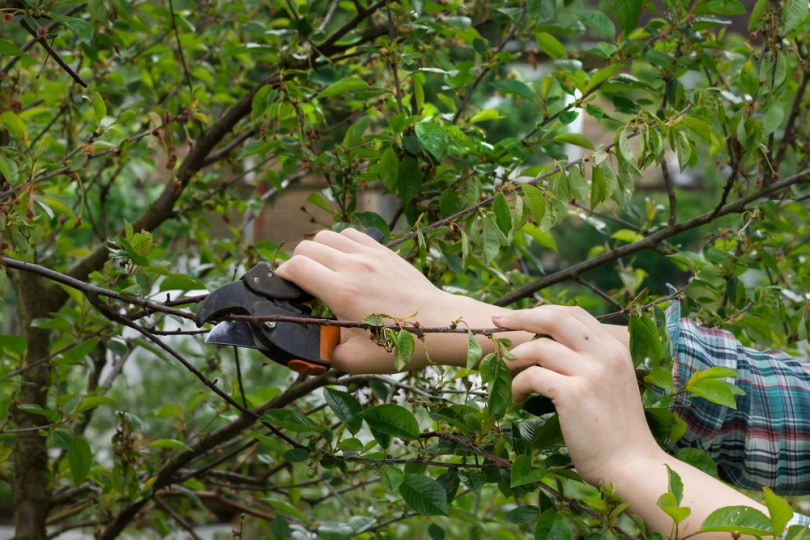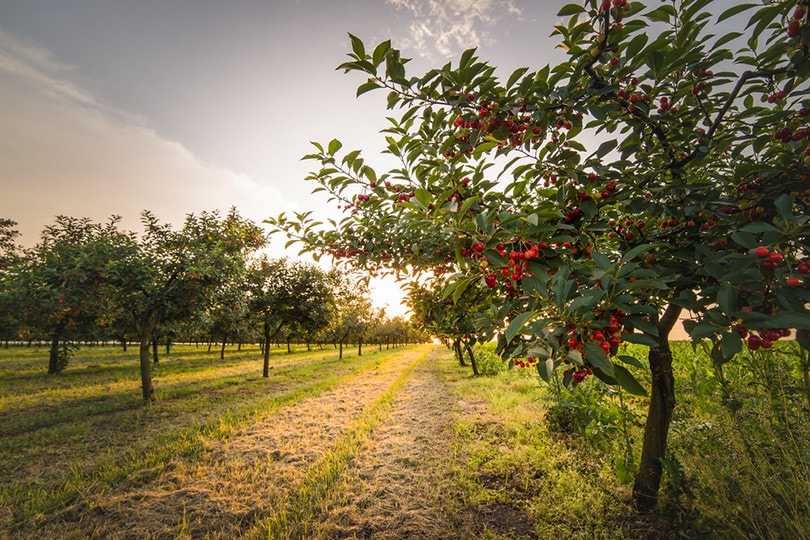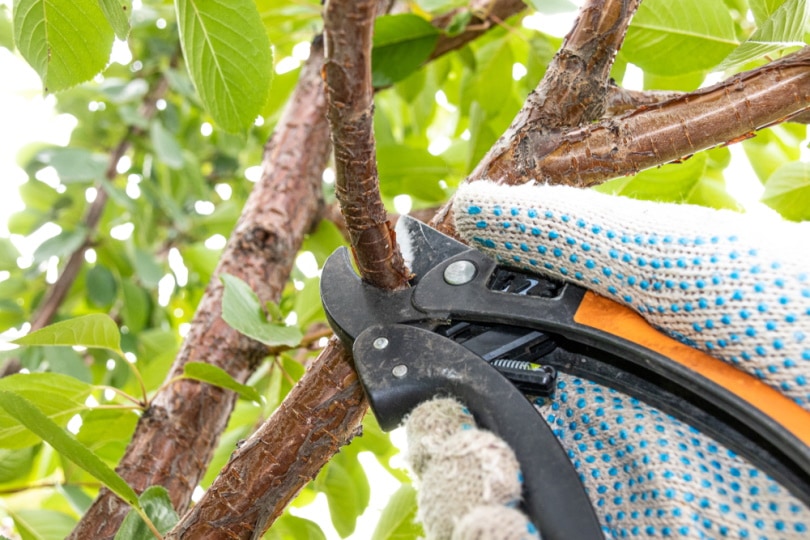How & When to Prune Cherry Trees: Tips, Seasons, & FAQ
-
Pete Ortiz
- Last updated:

Cherry trees are fruiting trees that make a lovely addition to a home garden. They have an ornamental appeal due to their delicious fruits and colorful foliage of beautiful pink and white flowers. A Cherry tree is so valued in Japan that it is considered a national symbol that even has its own national holiday.
Similar to other fruiting trees, cherry trees also need to be periodically trimmed to maintain their shape and allow future fruits to ripen. When left to overgrow, they can reach heights that make them almost impossible to harvest. Pruning allows the tree branches to grow, thus increasing fruit production and the growth of the aesthetically-pleasing plumage.
Pruning cherry trees can, however, be a daunting endeavor. It is hard to determine the right time to prune the tree because it is not completely obvious. You don’t want your tree to overgrow and, at the same time, you don’t want to over prune the tree so much that you leave only a stump that will probably take years to regenerate.
In this article, we will explore the reasons for pruning a cherry tree and how to prune one to ensure the trees are healthy, productive, and beautiful all year round.
Why Should You Prune a Cherry Tree?

The primary goal of pruning a cherry tree is to allow optimum access to sunlight and increase aeration. When the tree branches are pruned, it allows more sunlight to penetrate the leaves, therefore increasing food production, ease of fruit access, and the tree’s ability to fend off and fight pests and diseases.
In addition, pruning the diseased, damaged, or dead branches allows new and healthier branches to grow. The healthier branches will be able to handle the weight of cherries under heavy fruit production.
When Should You Prune a Cherry Tree?
There are varying opinions on the best time for pruning cherry trees. However, pruning times differ in terms of the season and the type or maturity level of the cherry tree. Many people prefer to prune in winter, while others prefer spring or summer pruning. Generally, cherry trees do not need that much care and attention compared to other fruiting trees. So, experts recommend pruning the trees when they are most dormant.
Winter Pruning
Winter is a suitable season for pruning large and older fruit tree vegetation. Cherry trees are not any different. In the winter season, the production is dormant, and the fruiting trees tend to lose their foliage, making it easier to see the damaged, overgrown, or diseased branches.
When you cut the branches off, you take away the energy spent growing the useless branches. However, pruning cherry trees during the winter season can be detrimental to the trees. Due to the low activity experienced at this time, there is minimal sap circulation, which may cause the cuts to take a longer time to heal. This can make the tree susceptible to fungal infections.

Summer Pruning
You can also prune your cherry trees during the summer season. This option is common among farmers who want to limit the growth rate of the tree. When untouched, these trees can grow as tall as a three-story building.
So, if you want your cherry tree to have a smaller height, you can prune it during the summer season. The shorter the height of the tree, the easier it will be to find and harvest ripe cherry fruits. It is also a great option to prevent the development of diseases.
Spring Pruning
Though not common, early spring is also an OK time for pruning cherry trees because you get to shape and train your tree before it blossoms. Spring pruning also aids in the production of healthy and strong cherry tree branches.
However, there are downsides to pruning during spring. It discourages the growth of the tree. Also, you risk cutting off the blooms that produce the sweet fruits.
How to Prune a Cherry Tree
The whole point of pruning cherry trees is to ensure that the trees grow in a particular way so there is a strong structure and foundation. Pruning also increases aesthetic properties by removing suckers and dead or damaged branches.
1. Gather Your Tools
Collect the necessary tools required for the process. These include a running saw, a hand runner, and long-handled lopping shears. These tools can be used for different pruning operations.
The Long-handled shears are great at reaching tall branches that are out of reach. Pruning saws work best for thick branches that normal sheers cannot handle. On the other hand, hand shears allow you to get up close and personal, especially when pruning young cherry trees.

2. Clean Your Tools
In the same way that medical practitioners clean their tools before attempting operations, so should you when pruning a cherry tree. It is an essential move because it prevents the spread of germs from the surface of the tools to the tree. You can clean the tools using alcohol-based substances to kill the germs that may be present.
To clean your tools, soak a rag in the alcohol solution. Then, proceed to vigorously rub the surface of your tool while paying close attention to the cutting blade.
3. Clear the Suckers From the Main Trunk
Suckers refer to branches that grow from the tree trunk. They tend to grow on the trunk when the plant is stressed. It is, however, important to get rid of the suckers to prevent the tree from growing in a direction that you may not like.
When cutting cherry tree suckers, always cut above the branch collar (nodule-like bump raised slightly above the surface of the main branch). Also, look for any damaged or broken tree branches and remove them as well.

4. Head the Tree
This is the process of cutting back the main shoots from the trunk to encourage the cherry tree to grow laterally. You can use a hand pruner or long-handled lopping shears to cut the branches of elongated branches that have no buds on them.
It is better to do this at the end of winter or early summer after the tree has developed cherry fruits. If you prune after the buds have developed, you risk reducing the number of fruits from your tree.
Conclusion
While it may seem like a laborious undertaking, regular pruning of your cherry trees is the best way to increase fruit production and their general aesthetic qualities. It not only boosts their health, but also ensures they are easy to manage.
Choosing the best time for pruning cherry trees usually takes some trial and error, depending on where you live. However, the best time is during the winter season. This is because the tree tends to be dormant, allowing you to see and remove the damaged branches that may inhibit fruit production or limit its aesthetic properties.
Featured Image Credit: Prune Cherry Tree, Shutterstock
Contents


